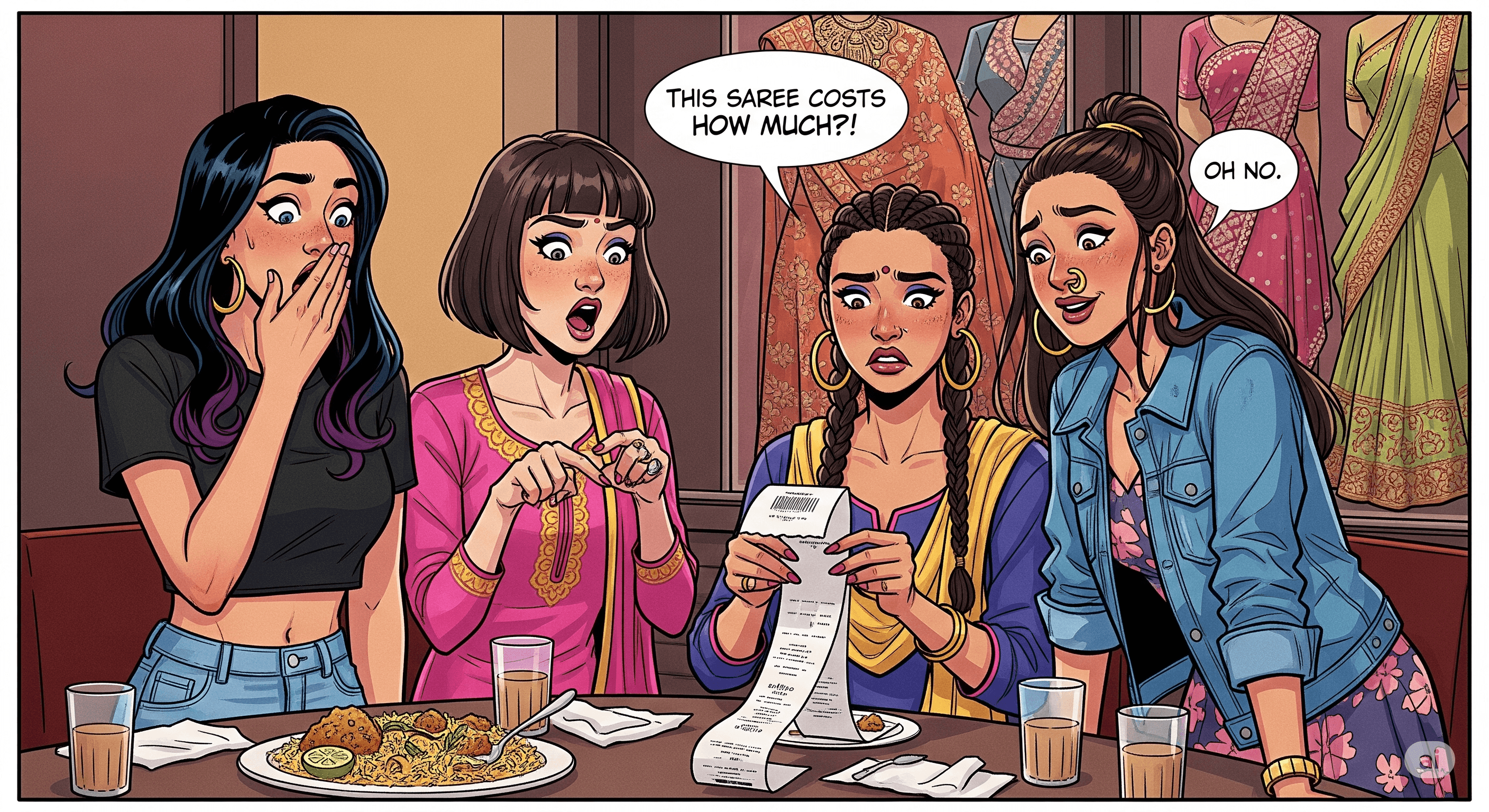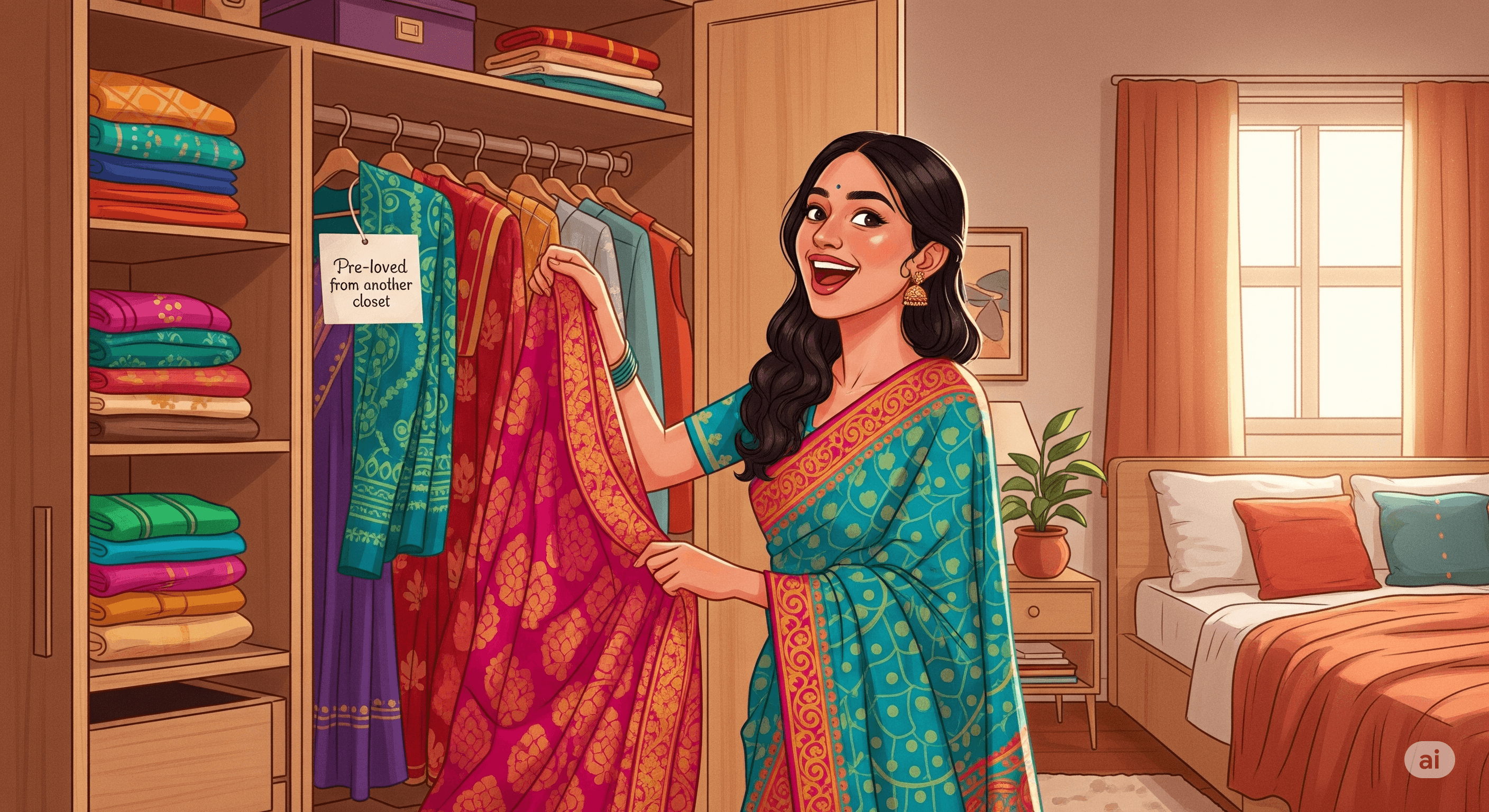The festive season in India sees a surge in women’s ethnic wear purchases, especially sarees. Celebration wear accounts for 1400 Billion where women's celebration wear makes up a significant share of the festive wear market, with an estimated value of ₹950 billion to ₹1,000 billion.
Crores of rupees are spent annually on new sarees, with women purchasing multiple pieces for each occasion. Lakhs of sarees are bought every year during this time, with an average woman buying 2–3 new sarees per season. This annual ritual often leads to impulsive buys, closet overload, and post-season regret.
According to a festive shopping index shared by the Retail Association of India (RAI) in 2021, fashion and apparel saw a 63% higher sales around the festive seasons, with sarees taking the center stage. In the years that have followed, these numbers have only climbed higher.
Buying Patterns and Demographics:
Estimates suggest around 33 crore women (out of approx. 67 crore women in India) spend an average of ₹3,500–4,000 annually on sarees for festivals and weddings. That implies total festive/wedding saree spending in the ballpark of ₹115,500–132,000 crore, which seems high relative to overall market size. In states like Karnataka, Andhra Pradesh, Chhattisgarh, Tripura, Odisha, West Bengal, Bihar, and Meghalaya, over 90% of households purchase at least one saree per year.
But the question is what do buyers as women do after they buy those sarees specific to occasions?
Use cases:
According to a survey conducted by us reportedly 94% women only wear sarees on special occasions with maximum repeat use cases being 2-3 times.
Around 50% women in India own at least 50 sarees in their cupboards while 16% confirms having 100+ sarees and rest 34% have more than 500+ sarees with numbers going up to 5000+ where a user called Savitri mentioned she has so many sarees in her wardrobe that she does not have to repeat for the next 2 years and can only wear each at a time.
Upper middle class ladies in Bengal spend around Rs.50,000/- during big festivals with one saree might be repeated once in 5 years.
The Hidden Cost of Festive Shopping
New sarees, especially those from premium or branded stores, can burn a hole in the pocket, costing anywhere between ₹5,000 to ₹50,000. Often, women forgo buying their dream sarees due to budget constraints—“next time” becomes never. After one wear (and an Instagram post), many sarees never see the light of day again. The true cost isn’t just monetary—it’s environmental and emotional waste too.

A new way to think about the cost of a saree is through the concept of cost per wear. Instead of looking at the saree’s initial price tag, this method focuses on how many times you actually wear it. It treats the saree like an asset that loses value each time you use it.
Here’s how the math works:
Initial Cost: The total price you paid for the saree.
Number of Wears: The total number of times you've worn the saree.
To find the cost per wear, you simply divide the initial cost by the number of times you’ve worn it.
Cost Per Wear= Number of Wears/ Initial Cost
For example, if you buy a saree for ₹5,000 and wear it only two times, your cost per wear is ₹2,500. This high cost can act as a trigger, revealing the financial and emotional impact of an impulse purchase. When you see how much each wear costs, it highlights the potential for regret when a beautiful garment remains unworn in your closet.
Why Not Try Something Different This Time?
This year, instead of rushing to buy new, exchange or buy preloved sarees. Imagine unboxing hidden gems from another woman’s wardrobe—rare, beautiful, and filled with stories. You get to wear a different saree for every occasion, all within the cost of just one new saree. This small shift lets you indulge without guilt, and brings purpose to your purchases. Preloved sarees are more than budget buy, they're a statement. They reduce textile waste, extend the life of handlooms, and support sustainability in a meaningful way.
You’re not just shopping; you're making a climate-conscious choice. Especially in a country like India, where handlooms are heritage so why not preserve, not discard?
Unneu offers a comprehensive experience where you can discover hidden gems from fellow saree lovers listed on the website from real wardrobes. Every preloved saree carries a story, a sentiment, a legacy. Shopping from fellow women builds a community of trust, sharing, and collective beauty. You’ll find styles not available in stores anymore, vintage weaves, and unique drapes that stand out in the crowd.
With ~55–86% expressing sustainability intent and ~37% increasing their second-hand apparel purchases, an estimated 40–60% of these saree-buying women may opt for preloved sarees therefore ~21–48 million women could be the estimated number of potential preloved saree buyers during the festive season.

Breaking the Stigma: 2nd-Hand Fashion in India
It’s time to ditch the taboo around second-hand clothes, especially sarees. Sarees are timeless and they don’t age with fashion cycles like fast fashion. With proper care and presentation, preloved sarees feel no different from new ones except in price and carbon footprint. And Gen Z’s are leading the way who are budget-friendly, yet style-obsessed. They’re bold enough to repeat looks, share wardrobes, and take pride in eco-conscious choices. Preloved doesn’t mean worn out rather you get next-to-new pieces at a fraction of the price. It's smart, savvy, and super stylish.
85–86% of Indian Gen-Z say they value brands that demonstrate environmental responsibility while 56% of Gen-Z take sustainable actions at purchase. 65% of GenZ prefer ethnic/fusion for occasions, especially for sarees. for special occasions and festivals.
India has around 175–200M women Gen-Z is India out of which 52–80M Gen-Z women buy ethnic pieces in festival seasons. Around 21–48M Gen-Z women in India are realistic active potential buyers for preloved sarees during festival seasons.
While tens of millions of young women are receptive to preloved sarees, this festival season, instead of buying one expensive new saree, you could wear a different preloved saree for every event — and still spend less than a single new premium piece.
Potential Savings from Choosing Preloved Sarees
Typically a new saree commonly ranges from ₹1,000 to ₹10,000; premium sarees (e.g., designer, silk) can reach ₹30,000 or more whereas preloved pieces selling for ₹500, ₹1,000–1,500.
So, If a preloved saree costs ₹1,000 versus a new saree that costs ₹5,000–10,000, that’s a ₹4,000–9,000 saving per saree leading to average conservative saving: ₹5,000 per saree.
So, this festive season redefines elegance with conscious choices to look stunning, be proud, and spend wisely. Choose elegance that doesn’t cost the Earth—literally and figuratively. Preloved sarees offer emotional, cultural, financial, and environmental value. You’re not just wearing a saree, you're wearing a mindset.
Buy preloved sarees from other women and enjoy a new saree for every event, without breaking the bank. Let your wardrobe reflect shared joy, mindful consumption, and beautiful choices.
This Festive Season, Shop Smarter — Shop Preloved. At www.unneu.com, discover next-to-new, premium preloved sarees handpicked from women across India. Save big, look fabulous, and be part of the conscious fashion movement that’s redefining elegance.
Save Money. Turn Heads. Make a Difference. Start your festive shopping now — because the best saree you’ll wear this season is one that’s already loved.
